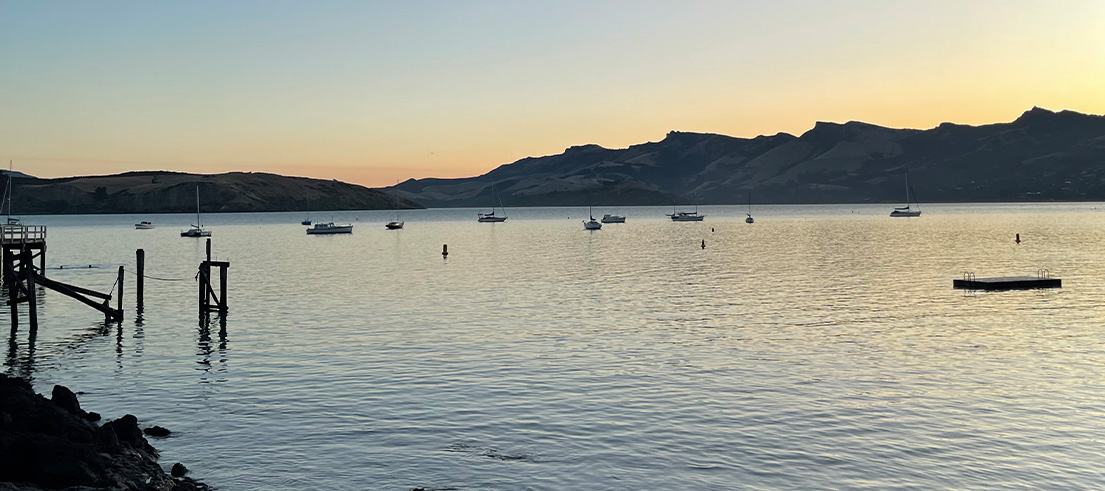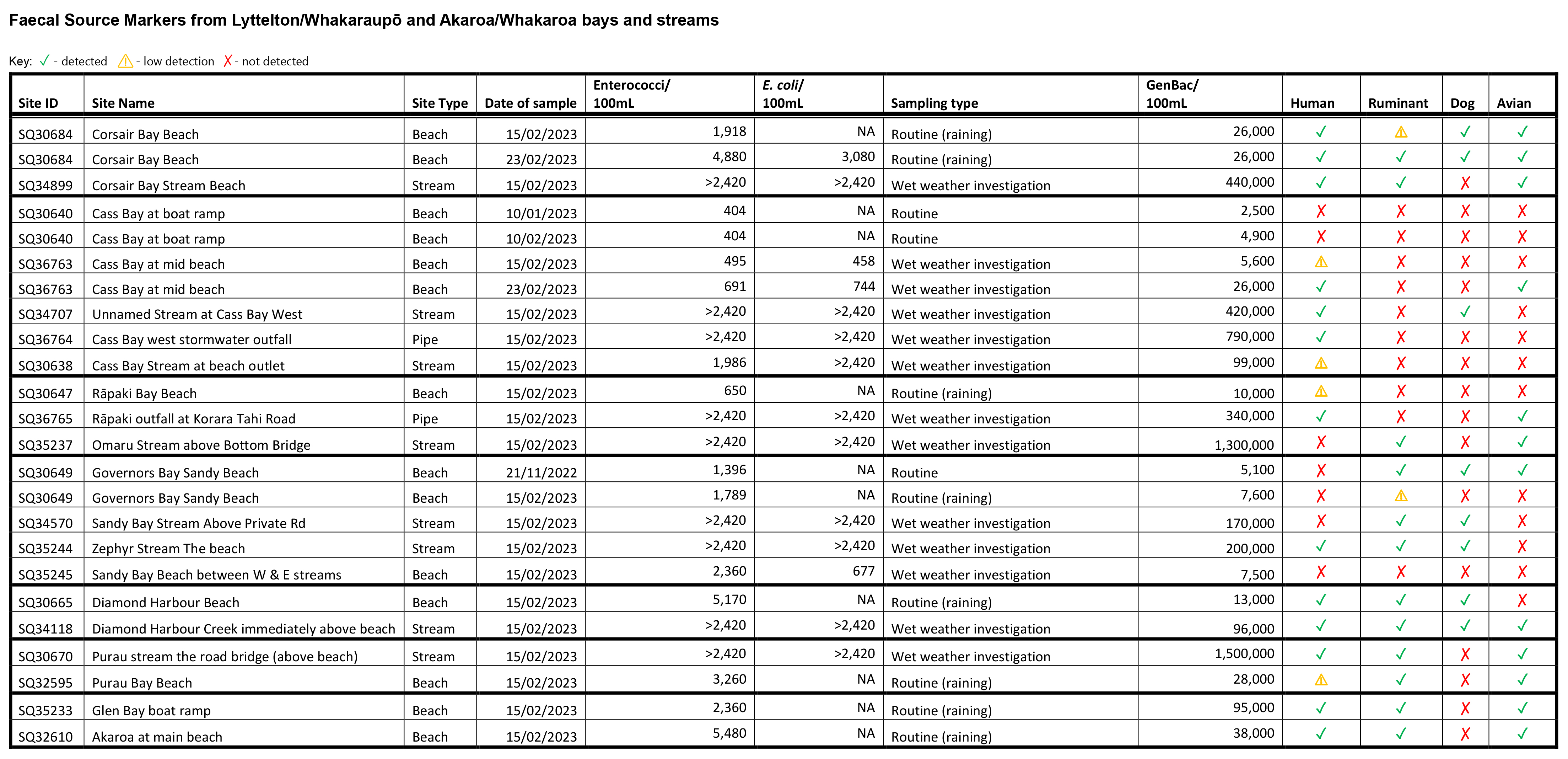
Recreational water quality results from Lyttelton Bays/Whakaraupō and Akaroa
We undertook faecal source testing earlier this year in many of the bays and waterways in Lyttelton Bays/Whakaraupō and Akaroa/Whakaroa to help determine what type of faecal pollution is entering these bodies of water after rainfall.
Surface water science manager Dr Elaine Moriarty said the results show that there is faecal contamination from humans and other sources (birds, dogs and livestock) in a number of the bays after rainfall events.
"Christchurch City Council is now leading an investigation into how these contaminants are entering waterways in the area. The investigation is complex as every public and private connection poses a potential contamination source, so investigations will take some time," she said.
Can I Swim Here?
Dr Moriarty said planning is underway to enhance our annual Can I Swim Here campaign, with the hopes the public can better understand the grading system and the risks surrounding swimming after rainfall.
"We have increased our monitoring efforts with extra testing done over the winter period. This is part of our project to move towards a live modelling monitoring system which would allow us to make continuous predictions of water quality for recreation.
"In many bays water quality fluctuates, especially after rainfall. When live modelling is launched, swimmers will be able to find out if a bay is safe for swimming on any specific day. This is still some time away, but we hope to have it live in future summers," Dr Moriarty said.
"We are working with Christchurch City Council, Te Whatu Ora, and local iwi to share information and assist with further testing where required. Public health is a top priority for all three agencies as we work together to improve water quality in Banks Peninsula," she added.
Check before you take a dip
Canterbury Medical Officer of Health Dr Cheryl Brunton said that it's always a good idea to check out the quality of water before you jump in.
"A number of sites within Lyttelton and Akaroa Harbours, including Akaroa Main Beach, Corsair Bay, Rāpaki Bay, Sandy Bay, Diamond Harbour Beach, Purau Beach, remain unsuitable for swimming due to the long-term grade and overall bacterial risk from contact with the water at these sites.
"One of the goals of the faecal source tracking project and the work that the agencies are doing to seek to identify sources of contamination and remediate them, is to over time see these sites improve in quality to the point where they can become suitable for swimming again," said Dr Brunton.
"However, after heavy rain other recreational water sites are also likely to be contaminated from rural and urban run-off. As a precaution, avoid swimming in the harbour, rivers, streams, lakes or estuaries for at least 48 hours after heavy or prolonged rainfall, even at sites that usually have good water quality."
Water contaminated by human or animal faecal matter may contain a range of disease-causing micro-organisms, such as viruses, bacteria and protozoa, which can cause gastrointestinal, respiratory, and skin infections. People should also avoid eating shellfish and mussels from the harbour after heavy rainfall. If fish are eaten, remove the gut and liver and wash them in clean water before cooking.
Collaborating to find sources of contamination
Christchurch City Council's Acting Head of Three Waters Brent Smith said investigations are getting underway.
"Finding out where contamination is coming from is a big job as there are so many potential sources.
"The sorts of things we'll be looking into include leaking septic tanks on private property, damaged public and private pipes, wastewater overflows, private cross connections, boats dumping wastewater, and freedom camping."
"One of the first steps we're taking is to carry out further sampling in two areas during periods of dry weather. This will fill in some of the gaps and supplement the sampling done over the summer period and following rainfall events."
Everyone plays a part in helping keep our waterways clean and healthy.
How you can help
- Report any spillages, leaks, or pollution you see near waterways or drains.
- Pick up dog poo - never leave it on walk tracks, pavements or the beach where it can wash into drains and waterways.
- Always use the public toilets provided.
- Ensure your boat is compliant and dispose of sewage waste correctly.
- Get your septic tank checked to make sure it is operating correctly.
For media enquiries regarding
- How the testing was done, please contact us at media@ecan.govt.nz.
- The investigations underway, please contact Christchurch City Council at mediaenquiries@ccc.govt.nz.
- Public health, please contact Te Whatu Ora at communications@cdhb.health.nz.
Faecal source tracking helps determine the origin of faecal pollution in water sources. This is done by looking at specific genetic markers or DNA patterns in the bacteria and comparing the markers found in the water samples to known markers (i.e., animal and human) to determine the likely source of the faecal pollution.
Several bays and streams around Lyttelton and Akaroa were sampled for faecal source tracking throughout the summer period - some as part of routine monitoring and some as investigations. Viable samples were analysed and above is a summary of the results. Faecal source tracking indicates if a genetic marker is present but cannot say how much is present. Some indications are weak and therefore are not a conclusive positive, as indicated in the table.
Notable observations
- Corsair Bay beach and stream had positive results for human and avian markers in all samples, with some positive with ruminant and dog markers.
- Cass Bay had positive results for human markers at the main beach and at two of the unnamed waterways in the west end of the bay.
- One stream in Rāpaki settlement had positive results for human and avian markers.
- Diamond Harbour beach and stream had positive results for human, ruminant and dog markers.
- Purau Stream had positive results for human, ruminant and avian markers, while Purau Beach had positive results for ruminant and avian markers.
- Both Akaroa Main Beach and Glen Bay (only locations sampled for faecal source tracking in Akaroa Harbour) had positive results for human, ruminant and avian makers.

